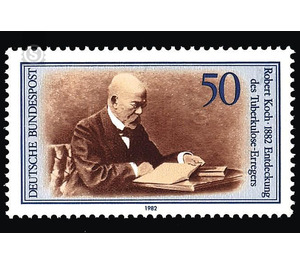100th anniversary of the discovery of the tuberculosis pathogen by Robert Koch - Germany / Federal Republic of Germany 1982 - 50 Pfennig
Theme: Art & Culture
| Country | Germany / Federal Republic of Germany |
| Issue Date | 1982 |
| Face Value | 50.00 |
| Color | brown |
| Perforation | K 14:14 1/4 |
| Printing Type | 4-color rotogravure |
| Stamp Type | Postage stamp |
| Item Type | Stamp |
| Chronological Issue Number | 995 |
| Chronological Chapter | GER-BRD |
| Michel ID | BRD 1122 |
| SID | 313689 |
| In 54 Wishlists | |
On March 24, 1882, Robert Koch, at that time a government councilor at the Berlin Imperial Physiological Society, delivered a lecture on the topic of "the aetiology of tuberculosis" to the Berlin Physiological Society, in which he found evidence of bacterial proliferation due to new staining methods and animal experiments Pathogen of tuberculosis. Only this pathogen detection made it possible to assign the widespread epidemic of tuberculosis, which at that time was one-seventh of the population, to infectious diseases. This discovery resulted in important changes in the control measures at that time. Because a direct attack on the pathogen was therapeutically not yet possible, the isolation of infectious patients in special hospitals and disinfection measures for the environment were in the future in the foreground. With great intensity, Robert Koch subsequently sought to find a remedy for this disease from substances of the pathogen, which should influence the pathogen in its growth by way of detour via the patient's own reactions. The substrate obtained from non-infectious culture filtrates of tuberculosis bacteria, which he called "tuberculin," unfortunately did not fulfill his high therapeutic expectations despite initial hopes. However, this tuberculin has become an indispensable diagnostic tool for the fight against tuberculosis since its use in skin tests makes it possible to sensitively detect even old, dormant infections that have not or not yet led to forms of disease. In 1905 Robert Koch was awarded the Nobel Prize, mainly for the discovery of the tuberculosis pathogen. Only about 60 years after this discovery, many efforts have been successful in developing drugs that can directly attack the pathogen and kill it in a few weeks without harming the patient. The associated rapid elimination of the previously dreaded bacterial spread by tuberculosis patients resulted in a drastic reduction in infectious and disease cases. In the meantime, with the development of other drugs, virtually every type of tuberculosis can be successfully treated. Thus, thanks to Robert Koch's pioneering discovery, it can be expected that the former epidemic of tuberculosis in developed countries will be eradicated in the foreseeable future. (Text: Federal Ministry for Youth, Family and Health, Bonn)
| Condition | Name | In Stock | Price | Price + Shipping | Store | |
|---|---|---|---|---|---|---|
 | Unmounted Mint ** | 100th anniversary of the discovery of the tuberculosis pathogen by Robert Koch - Germany / Federal Republic of Germany 1982 - 50 Pfennig | 10 | US $1.07 | US $4.26 |  FILATELIELOKET (0) FILATELIELOKET (0)Shipping US $3.19 Minimum Order US $2.67 |


